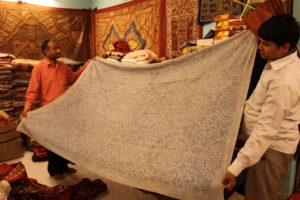The French name for a needlework technique found across the world, in which one fabric is stitched over another – whether a badge onto a school blazer, a patch to cover a hole, or a complex patchwork. The leather patches on the elbows of jackets are in effect applique; in fact any applied work is technically appliqué.
This type of all-over applique is very beautiful, the appliqué is made with two layers of fabric worked together. The top piece has a formalised, or at least a drawn, pattern which defines the design and the work. The top layer is cut, the edges folded underneath and stitched down.
We’re being shown the whole piece in the rug shop.
Each stitched section looks like a tiny window onto the piece behind. And if one of these is pinned onto a window or used as a blind it looks like a beautiful coloured glass window when the sun shines through. Especially as here ( the colours haven’t come out so well ) the back is slightly gold beneath a soft blue grey top.
The overall design of this particular piece resembles a carved wooden jali screen.
These appliqué pieces are generally used and made, sized, for bedcovers and pillows but as window treatments they are stunning; make to size to prevent cutting through the design.
In other usage:
Appliqué might be chosen for decorative reasons or to disguise; the applied works can be hand sewn or machine stitched over raw or turned-under edges. For centuries the Amish community have used appliqué in their quilts, as have the Sindh women of Pakistan when making their Ralli quilts.


